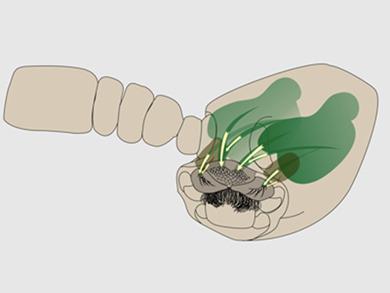当前位置:
X-MOL 学术
›
J. Morphol.
›
论文详情
Our official English website, www.x-mol.net, welcomes your
feedback! (Note: you will need to create a separate account there.)
Profound head modifications in Claviger testaceus (Pselaphinae, Staphylinidae, Coleoptera) facilitate integration into communities of ants
Journal of Morphology ( IF 1.5 ) Pub Date : 2020-07-18 , DOI: 10.1002/jmor.21232 Paweł Jałoszyński 1 , Xiao-Zhu Luo 2 , Rolf Georg Beutel 2
Journal of Morphology ( IF 1.5 ) Pub Date : 2020-07-18 , DOI: 10.1002/jmor.21232 Paweł Jałoszyński 1 , Xiao-Zhu Luo 2 , Rolf Georg Beutel 2
Affiliation

|
Clavigeritae is a group of obligate myrmecophiles of the rove beetle subfamily Pselaphinae (Staphylinidae). Some are blind and wingless, and all are believed to depend on ant hosts through feeding by trophallaxis. Phylogenetic hypotheses suggest that their ancestors, as are most pselaphines today, were free‐living predators. Morphological alterations required to transform such beetles into extreme myrmecophiles were poorly understood. By studying the cephalic morphology of Claviger testaceus, we demonstrate that profound changes in all mouthpart components took place during this process, with a highly unusual connection of the maxillae to the hypopharynx, and formation of a uniquely transformed labium with a vestigial prementum. The primary sensory function of the modified maxillary and labial palps is reduced, and the ventral mouthparts transformed into a licking/‘sponging’ device. Many muscles have been reduced, in relation to the coleopteran groundplan or other staphylinoids. The head capsule contains voluminous glands whose appeasement secretions are crucial for the beetle survival in ant colonies. The brain, in turn, has been shifted into the neck region. The prepharyngeal dilator is composed of an entire series of bundles. However, the pharynx does not show any peculiar adaptations to taking up liquid food. We demonstrate that far‐reaching cephalic modifications characterize C. testaceus, and that the development of appeasement glands and adaptation of the mouthparts to trophallaxis determine the head architecture of this extreme myrmecophile.
中文翻译:

Claviger testaceus(Pselaphinae、Staphylinidae、Coleoptera)中深刻的头部修饰促进了与蚂蚁群落的融合
Clavigeritae 是 rove 甲虫亚科 Pselaphinae (Staphylinidae) 的一组专性食蚁兽。有些是盲目的和无翅的,据信所有这些都依赖于蚂蚁寄主,通过 trophallaxis 取食。系统发育假设表明,它们的祖先和今天的大多数 pselaphine 一样,是自由生活的捕食者。人们对将这种甲虫转变为极端嗜螨虫所需的形态学改变知之甚少。通过研究 Claviger testaceus 的头部形态,我们证明在这个过程中所有口器成分都发生了深刻的变化,上颌骨与下咽部的连接非常不寻常,并形成了具有退化性前唇的独特转化的阴唇。改良的上颌和下唇触须的主要感觉功能降低,腹侧口器变成了舔/“海绵”装置。与鞘翅目平面图或其他葡萄球菌素相关的许多肌肉都减少了。头囊包含大量腺体,其分泌物对甲虫在蚁群中的生存至关重要。反过来,大脑已经转移到颈部区域。咽前扩张器由一整套束组成。然而,咽部对于摄取流质食物并没有表现出任何特殊的适应性。我们证明了影响深远的头部修饰是 C. testaceus 的特征,并且绥靖腺的发育和口器对 trophallaxis 的适应决定了这种极端嗜热菌的头部结构。与鞘翅目平面图或其他葡萄球菌素有关。头囊包含大量腺体,其分泌物对甲虫在蚁群中的生存至关重要。反过来,大脑已经转移到颈部区域。咽前扩张器由一整套束组成。然而,咽部对摄取流质食物没有表现出任何特殊的适应性。我们证明了影响深远的头部修饰是 C. testaceus 的特征,并且绥靖腺的发育和口器对 trophallaxis 的适应决定了这种极端嗜热菌的头部结构。与鞘翅目平面图或其他葡萄球菌素有关。头囊包含大量腺体,其分泌物对甲虫在蚁群中的生存至关重要。反过来,大脑已经转移到颈部区域。咽前扩张器由一整套束组成。然而,咽部对于摄取流质食物并没有表现出任何特殊的适应性。我们证明了影响深远的头部修饰是 C. testaceus 的特征,并且绥靖腺的发育和口器对 trophallaxis 的适应决定了这种极端嗜热菌的头部结构。咽前扩张器由一整套束组成。然而,咽部对摄取流质食物没有表现出任何特殊的适应性。我们证明了影响深远的头部修饰是 C. testaceus 的特征,并且绥靖腺的发育和口器对 trophallaxis 的适应决定了这种极端嗜热菌的头部结构。咽前扩张器由一整套束组成。然而,咽部对于摄取流质食物并没有表现出任何特殊的适应性。我们证明了影响深远的头部修饰是 C. testaceus 的特征,并且绥靖腺的发育和口器对 trophallaxis 的适应决定了这种极端嗜热菌的头部结构。
更新日期:2020-07-18
中文翻译:

Claviger testaceus(Pselaphinae、Staphylinidae、Coleoptera)中深刻的头部修饰促进了与蚂蚁群落的融合
Clavigeritae 是 rove 甲虫亚科 Pselaphinae (Staphylinidae) 的一组专性食蚁兽。有些是盲目的和无翅的,据信所有这些都依赖于蚂蚁寄主,通过 trophallaxis 取食。系统发育假设表明,它们的祖先和今天的大多数 pselaphine 一样,是自由生活的捕食者。人们对将这种甲虫转变为极端嗜螨虫所需的形态学改变知之甚少。通过研究 Claviger testaceus 的头部形态,我们证明在这个过程中所有口器成分都发生了深刻的变化,上颌骨与下咽部的连接非常不寻常,并形成了具有退化性前唇的独特转化的阴唇。改良的上颌和下唇触须的主要感觉功能降低,腹侧口器变成了舔/“海绵”装置。与鞘翅目平面图或其他葡萄球菌素相关的许多肌肉都减少了。头囊包含大量腺体,其分泌物对甲虫在蚁群中的生存至关重要。反过来,大脑已经转移到颈部区域。咽前扩张器由一整套束组成。然而,咽部对于摄取流质食物并没有表现出任何特殊的适应性。我们证明了影响深远的头部修饰是 C. testaceus 的特征,并且绥靖腺的发育和口器对 trophallaxis 的适应决定了这种极端嗜热菌的头部结构。与鞘翅目平面图或其他葡萄球菌素有关。头囊包含大量腺体,其分泌物对甲虫在蚁群中的生存至关重要。反过来,大脑已经转移到颈部区域。咽前扩张器由一整套束组成。然而,咽部对摄取流质食物没有表现出任何特殊的适应性。我们证明了影响深远的头部修饰是 C. testaceus 的特征,并且绥靖腺的发育和口器对 trophallaxis 的适应决定了这种极端嗜热菌的头部结构。与鞘翅目平面图或其他葡萄球菌素有关。头囊包含大量腺体,其分泌物对甲虫在蚁群中的生存至关重要。反过来,大脑已经转移到颈部区域。咽前扩张器由一整套束组成。然而,咽部对于摄取流质食物并没有表现出任何特殊的适应性。我们证明了影响深远的头部修饰是 C. testaceus 的特征,并且绥靖腺的发育和口器对 trophallaxis 的适应决定了这种极端嗜热菌的头部结构。咽前扩张器由一整套束组成。然而,咽部对摄取流质食物没有表现出任何特殊的适应性。我们证明了影响深远的头部修饰是 C. testaceus 的特征,并且绥靖腺的发育和口器对 trophallaxis 的适应决定了这种极端嗜热菌的头部结构。咽前扩张器由一整套束组成。然而,咽部对于摄取流质食物并没有表现出任何特殊的适应性。我们证明了影响深远的头部修饰是 C. testaceus 的特征,并且绥靖腺的发育和口器对 trophallaxis 的适应决定了这种极端嗜热菌的头部结构。











































 京公网安备 11010802027423号
京公网安备 11010802027423号